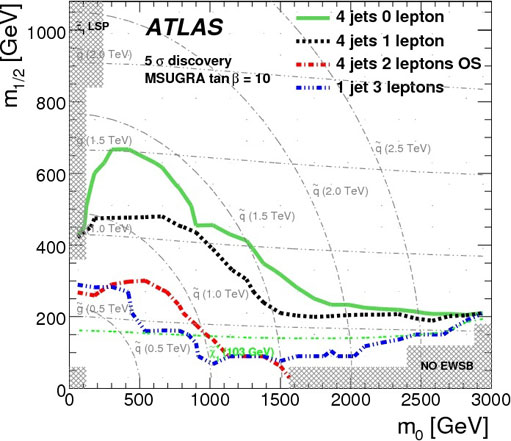
ATLAS e-News
23 February 2011
The CSC saga draws to a close
6 October 2008

Discovery potential of ATLAS for an mSUGRA model for various channels with four jets and missing ET, as a function of the two SUSY parameter masses m0 and m1/2. Consult the CSC book to find out more!
After three years of studies and preparations, the results of the performance studies that were done as part of the ATLAS Computing System Commissioning - "CSC" - exercise are now almost complete. The CSC programme grew out of the earlier "data-challenge" exercises, and the rough shape of the CSC notes was hammered out in 2005-2006. The idea was to have a series of notes reporting the physics readiness of ATLAS in a range of areas, covering detector and trigger performance, and physics analysis stretching from the J/psi to TeV-scale gravity. These notes document the expected physics capabilities of ATLAS, using more realistic simulations and reconstruction algorithms than previously available.
The CSC studies used a common set of Monte Carlo samples for most of the work. The simulation, digitisation and reconstruction of these samples was carried out by the ATLAS distributed computing system, using the Grid. This, together with the use of the latest software available at the time (releases 12 and 13 for different studies), was what led to the "Computing System Commissioning" name. A variety of technical problems were found on the way (remember the "1mm bug"?), and the learning process was extremely valuable. In all, around 1300 different datasets were generated representing different physics processes or models. The grand total of events simulated numbers about 200 million.
A mammoth tome is being prepared to document the results of these studies, which span from the trigger, through combined performance, to physics analysis sensitivity studies. This "CSC book" is expected to sum up to nigh on 2000 pages when fully assembled together. Finalising the analyses, writing, editing and reviewing the summary notes - of which there are 77 in the book, grouped into 14 chapters - has taken the best part of the last year. A couple of hundred collaborators have been involved in the reviewing process, and a lot has been learnt in the process. Most would agree that this has been a good initiation into the preparation of ATLAS publications. The later stages of review have been steered by the Publications Committee (PubComm), and the members of PubComm have been heavily involved in the latest stage of reviewing. In addition, the individual chapters of the book were announced to the Collaboration for comments during the summer, and a further final circulation is anticipated before the book is complete.
The title of the book has already been fixed: Expected Performance of the ATLAS Experiment - Detector, Trigger and Physics. We are planning to submit the book also to the preprint archive. Given the number of pages, it is perhaps most appropriate that the whole document will usually be consulted electronically.
The book will be signed by the whole Collaboration: a testament to the work of all who contributed to the design and construction of the experiment, to the complete reconstruction of the ATLAS software, of those operating the computing system on the Grid, and to those contributing the final performance and analysis studies.

Karl JakobsFreiburg University, Germany |

Dave CharltonUniversity of Birmingham, UK
|